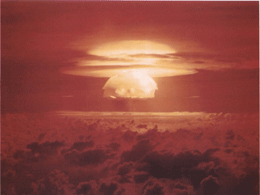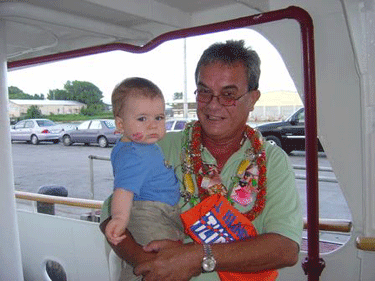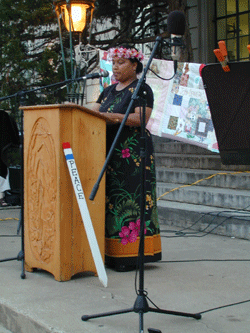From the Islands to the Ozarks
Air Date: Week of June 30, 2006

The Castle Bravo Blast in March 1954. (Credit: Photo Courtesy of: U.S. Airforce)
Many Marshall Islanders, transplanted to Arkansas’ Ozark Mountains, carry the legacy of post-World War II atomic testing. Some continue to suffer poverty and illness. Jacqueline Froelich reports from Fayetteville, Arkansas.
Transcript
CURWOOD: It’s Living on Earth, I’m Steve Curwood. In scattered towns across the United States, you'll find communities of folk from the islands of the Pacific. In the Ozark Mountains of Arkansas, for example, people from the five islands and 29 coral atolls of the Marshall Islands have been arriving in search of the same things that draw other immigrants: better jobs and education.
But the Marshall Islanders also bring something else: memories of the 67 atomic and thermonuclear weapons tests staged there between 1946 and 1958. Hundreds of islanders were evacuated from atolls where the bombs were exploded. The blasts disrupted life there and contaminated the land. Some islanders still cannot go home. And some say they still pay a price in illness and poverty for their Cold War cooperation. From Fayetteville, Arkansas, Jacqueline Froelich has their story.
[SOUND OF INSECTS, CHILD’S VOICE CALLING]
FROELICH: Six thousand miles from the Marshall Islands, there’s now an Islander neighborhood in the chicken processing town of Springdale, Arkansas.
[CHILD TALKING]
FROELICH: When school is out, Islander kids ride bikes and skate between the faded houses.
[SINGING]
FROELICH: Sitting on a sofa in an open garage, two Islander women sing to eight children playing quietly at their feet.
[SINGING]
FROELICH: It’s customary for women to keep children at home, says Lumon Benjamin, Arkansas Marshallese community president. Benjamin’s home, like others here, is decorated with lots of island mementos, cascades of artificial flowers and family photographs. He concedes that Islanders are here by choice, but maybe not first choice.
BENJAMIN: I miss the water, the clear water. I miss the oceans, I miss fishing! I always fished every day. There are many other things that are really different from back home – I have not seen any sailing canoes over here! (laughs). That is our main transportation back home.
FROELICH: Back home, Benjamin taught elementary school. Now he makes four times as much money working the midnight shift at a metal siding plant. He says it took a while to get used to the lakes, mountains, shopping centers – even the street lights. And he alludes to another draw, besides jobs.
BENJAMIN: And the hospitals, they are really big. That is one of the main reasons the people want to come over here. They want to be near these big hospitals because of their sicknesses and these things.
FROELICH: Benjamin’s family is originally from the Marshall Island’s Bikini Atoll, where in 1954 the United States conducted its biggest test, a 15-megaton hydrogen bomb. The operation, code-named Bravo, was one of many detonated on Bikini, as well as Enewetak Atoll. The explosion was equivalent to a thousand Hiroshima-sized bombs, and pulverized large portions of coral reef, irradiating the land and sea.
The U.S. Navy, along with Atomic Energy Commission personnel, evacuated people, including Benjamin’s family, from test sites like Bikini before the tests. They were allowed to go back twenty years later. But then it was determined that drinking water on Bikini was still too radioactive, so, six years after that, islanders had to leave once again. In the meantime, some may have received a dose.
BENJAMIN: Right now, I have a lot aunties, and also uncles, they died. They had the sicknesses with them until their body cannot fight it anymore. I got two this year, they passed away. My sister also passed away last year because of cancers.
FROELICH: The testing continued for more than a decade. Islanders on nearby atolls often were not evacuated during the tests. They were deemed to be at a safe distance.

Tony Debrum holding honorary nephew, Lucas Sherman, aboard the "Oleander"near Majuro. (Photo: Jessica Reimers-Langijota)
Former Marshallese Minister of Health Tony Debrum was a nine-year-old boy fishing with his grandfather on the beach of Likiep Atoll when he witnessed the Bravo test on the northwest horizon.
DEBRUM: First the flash, which, at 187 miles away, still managed to blind us. And then I describe it as if we were standing under a glass bowl, and someone poured blood on it. The whole sky turned red, the beach was red, the fish I had in my basket was red, my grandpa was red, his net was red. But I kept hearing him say, “run, run, run to the house, run to the house,” but I couldn’t run. I was too scared.
FROELICH: Bravo’s mushroom cloud rose 100,000 feet up into the atmosphere, and according to the Atomic Energy Commission, fallout reached as far as Memphis, Tennessee. Prevailing winds that morning spread fallout eastward over the populated atolls of Rongelap and Utirik.
Anthropologist Holly Barker has conducted hundreds of ethnographic interviews with survivors. She serves as a senior advisor to the Marshallese Embassy.

The Castle Bravo Blast in March 1954. (Courtesy of U.S. Airforce)
They just didn't know what it was, and they didn't know it was harmful to them. So when it fell in their water and they drank that water, and fell on their food and they consumed the food, they didn’t understand the connection between starting to feel ill and the radiation.
FROELICH: Reno James is one of about a hundred people still living who witnessed Bravo and experienced the fallout. He first felt the blast from inside his two-room thatched cabin on Utirik Atoll, downwind east of the Bravo Shot. He was 16.
JAMES: And we was hear the noise, the big noise, and our island is shaken and its lightning. Some of trees, the coconut, fell down. And also after that, the powder is dripping down, and after a couple of hours the people become sick, and some people like me, I was vomiting, very dizzy.
See my grandfather, my father’s father, he passed away because he got so many kinds of sick. Some things come out on the skin, is like mumps, really big. Some kind of sickness we didn’t have before, and it’s why he died.
FROELICH: A U.S. Navy ship equipped with medical personnel arrived three days later to treat their radiation sickness. James now has thyroid cancer.
The Republic of the Marshall Islands declared independence in 1986, but maintains a strategic relationship with the United States. An agreement allowed the U.S. to keep an Army base on Kwajalein Atoll in the central Marshalls. There they test ballistic missiles and missile interceptors, support NASA space operations, and assist the U.S. space command with satellite tracking and surveillance.
In exchange, the U.S. helps pay for public education, health and government operations in the Marshalls. Another benefit is one many prospective immigrants would relish: Islanders are free to travel and work in the U.S. for as long as they wish. The compact also provided compensation for damages from the nuclear testing. A Nuclear Claims Tribunal dispensed 72 million dollars in personal injury claims to 2,000 survivors.
Dr. Neal Palafox is a University of Hawaii professor and family practice physician. He also has been a principle investigator for the Department of Energy Marshall Islands Nuclear Victims Program. He says 50 years after the tests, exposed islanders, including those in utero at the time of the tests, those allowed to return early, and cleanup workers, still live with effects, including thyroid disease, mental retardation and many types of cancer.
PALAFOX: The cancers that have been shown are breast, lung cancer, thyroid cancer, brain cancer, stomach, intestine cancer, skin, mouth cancer, bone cancer, liver cancer and kidney cancer. All those have definitely been linked to long term effects of direct radiation exposure in high doses.
FROELICH: Many Marshall Islanders have other health conditions that may not be related to their special history, conditions such as obesity and diabetes.
Before European explorers arrived, the indigenous Marshallese caught reef fish and crabs and grew breadfruit, taro, and pandanas, in their atolls’ sometimes poor sandy soils. The islands’ carrying capacity was limited, infant mortality was high, with intermittent typhoons and famine. More outside contact meant food was more abundant, but now it included white flour, rice and sugar. Locally grown foods were abandoned for convenience. Christian missionaries discouraged birth control. Dr. Palafox says the islands’ public health system is overwhelmed and cannot cope with the Islanders’ great needs.
PALAFOX: They approach the Ministry of Health in the Marshall Islands, but it cannot provide adequate care. So many of them actually go without necessary care that they should receive.
FROELICH: Now, overpopulation, the desire for better jobs, dislocation from radioactive atolls and sickness have all triggered a Marshallese diaspora. Of the islands’ estimated 60,000 residents, 10,000 have immigrated to the United States, most settling in northwest Arkansas. Arkansas Marshallese cultural liaison Carmen Chong-Gum says her people have something special to offer.

Carmen Chong-Gum speaking in Fayetteville, Arkansas at the annual “Remembrance of Victims of War Day.” (Photo: Joannie Conners)
[BELL RINGING AND RECITATION OF NAMES OF THE DEAD]
FROELICH: In memory of those who have suffered and died from the testing, Chong-Gum organizes an annual Nuclear Victims Day in Springdale.
[CHURCH YOUTH CHOIR; INCANTATIONS]
FROELICH: The three-hour-long program featured several processions, testimony from survivors, and a church youth choir. Hundreds of islanders of all ages showed up
[CHURCH YOUTH CHOIR]
FROELICH: This year, Chong-Gum, for the first time, showed a documentary film about the Bravo Test.
[HISTORIC FILM SOUNDTRACK: ‘COUNTDOWN 12, 11, 10, 9…ZERO…EXPLOSION…]
FROELICH: It was eerie watching Islanders, sitting motionless, watching themselves on the big screen. Most, like seventeen-year-old Crystalahni Jack, had never seen these unsettling archival images.
FROELICH: How did it make your feel?
JACK: It made me feel sad. Sad knowing that some of the people that was part of the Bikini Island couldn’t go back to the Bikini island because they had poisoned over there, so they could not go back there to live in their own island.
FROELICH: Do you think young talk about this? Do young Marshallese talk about this?
JACK: Yeah. Everybody talk about it. Even young kids talk about. It’s a big thing that happened to the Marshall Islands. They don’t want to forget it because it’s what affected the people of the Marshall Islands.
FROELICH: Now, five decades later, the U.S. State Department says compensation to islanders directly affected by the test program should be considered paid in full. Former Marshallese Minister of Health Tony Debrum was a co-author of the original compensation agreement.
DEBRUM: The problem is the United States is trying to limit its liability to islands that it says were exposed when, in fact, now we know that many, many more than the four atolls were exposed.
FROELICH: Debrum is referring to the long-held U.S. government position that only four atolls in the Marshall Islands were affected by the nuclear tests. New estimates by the National Cancer Institute, however, indicate that all of the Marshalls were exposed to radiation. NCI researchers testified before Congress they estimate 290 more radiation-related cancers still to develop beyond 2004, especially among islanders who were children during the testing. The Marshallese government is asking for 3 billion dollars in additional compensation.
FALEOMAVAEGA: Mr. Chairman, I submit this is much larger than a legal issue. This is a moral issue.
FROELICH: In a packed Senate Committee hearing, U.S. Congressman Eni Faleomavaega, ranking member of the International Relations Subcommittee on Asia and the Pacific, testified on the Marshall Islands behalf:
FALEOMAVAEGA: The fact is, the people of the Marshall Islands are still suffering severe adverse health effects directly related to our nuclear testing program, and they are still unable to use their own lands because of the radiation poisoning. We have a moral obligation to provide for health care, environmental monitoring, personal injury claims, and land and property damaged in the Marshall Islands.
FROELICH: But Howard Krawitz, at the U.S. State Department's East Asia and Pacific desk, has a different view. Tape of his Senate testimony was not available, and he declined through a spokesman to be interviewed, but he said the United States recognizes there are serious and continuing public health and medical challenges for Marshall Islanders.
But he said the United States will already spend 16 million dollars in health care funds in 2005 in accordance with the compact. Since the 1950s, he pointed out, the country has spent hundreds of millions of dollars on health and environmental problems related to the nuclear tests. Krawitz testified that additional expenditures in the billions of dollars are not warranted.
Back in Arkansas, physicians are getting used to seeing islanders in their clinics. One physician interviewed says practitioners are learning they need to admit Marshallese patients to hospital when they first get an infection. Their immune systems, she says, seem to be compromised.
To better serve Marshallese with their unusual health issues, providers have been gearing up. Medical anthropologist Dee Anna Perez Williams surveyed islanders for Northwest Arkansas Radiation Therapy Institute’s cancer prevention and outreach program.
PEREZ WILLIAMS: One of the main reasons they have migrated to the United States is because of their health. However, ideally, they would like to stay in their homeland. They would like to stay there and make a living, have the health resources, have the educational resources and benefits, because that’s their home.
[MARSHALLESE ANTHEM SUNG AT VICTIMS DAY EVENT]
FROELICH: But for now, these Pacific Islanders are choosing the Ozark Mountains as their home away from home. For Living on Earth, I’m Jacqueline Froelich in Fayetteville, Arkansas.
Links
Living on Earth wants to hear from you!
Living on Earth
62 Calef Highway, Suite 212
Lee, NH 03861
Telephone: 617-287-4121
E-mail: comments@loe.org
Newsletter [Click here]
Donate to Living on Earth!
Living on Earth is an independent media program and relies entirely on contributions from listeners and institutions supporting public service. Please donate now to preserve an independent environmental voice.
NewsletterLiving on Earth offers a weekly delivery of the show's rundown to your mailbox. Sign up for our newsletter today!
 Sailors For The Sea: Be the change you want to sea.
Sailors For The Sea: Be the change you want to sea.
 The Grantham Foundation for the Protection of the Environment: Committed to protecting and improving the health of the global environment.
The Grantham Foundation for the Protection of the Environment: Committed to protecting and improving the health of the global environment.
 Contribute to Living on Earth and receive, as our gift to you, an archival print of one of Mark Seth Lender's extraordinary wildlife photographs. Follow the link to see Mark's current collection of photographs.
Contribute to Living on Earth and receive, as our gift to you, an archival print of one of Mark Seth Lender's extraordinary wildlife photographs. Follow the link to see Mark's current collection of photographs.
 Buy a signed copy of Mark Seth Lender's book Smeagull the Seagull & support Living on Earth
Buy a signed copy of Mark Seth Lender's book Smeagull the Seagull & support Living on Earth

